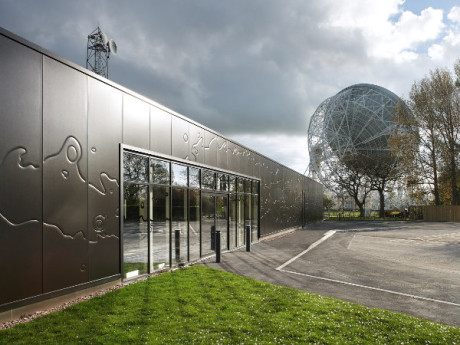
In the week Monday 30th January to Friday 3rd February 2017 I was fortunate enough to have the chance to attend the Jodrell Bank Centre for Astrophysics work experience. It was held mainly in the Turing Building on the Manchester University Campus.
I was in a group along with 11 other people and we started off the week with a small introduction which involved giving a short talk about ourselves and a game where we had to order a list of different units in size order. This was surprising to me as I found that there are actually more unique ways to shuffle a deck of 52 cards than there are galaxies in the observable universe!
In the afternoon of the first day we learnt how to measure the flux of a star (which is basically the amount of energy that passes through a certain area each second) using a piece of computer software and a special image taken by radio telescopes. This is important as if we observe the star at different frequencies we can measure the flux of each different frequency, allowing us to determine the ‘colour’ of the star. The colour of the star can tell you about the metallicity which is the ratio of iron to hydrogen in the star. After you know the metallicity you can then use computer generated models to predict the age of the star using plots on a Hertzsprung Russel diagram.
This led on to us being given the project of the week which was to determine the age of the M5 globular cluster with the goal of presenting our results in a thirty-minute seminar to the other professors and students at the end of the week.
On the Tuesday we spent the morning gathering some data for our project. We then spent the afternoon talking to some current undergraduate and PhD students. This was useful as it gave me an idea as to what it would be like to study physics at Manchester university: brilliant!
The next day then developed the theme by showing us what it is like to work in the field of astrophysics when we went on a trip to Jodrell Bank Observatory. I found the visit both fun and interesting: we had a few talks from employees about what they do and about radio astronomy. They were detecting pulsars when we visited the observatory and we were taught about how this is done.
Thursday and Friday were then spent preparing and researching for our seminar. We had a workshop using IsaacPhysics which is really useful for preparing you with problem solving skills for the kind of work you have to do in physics degrees or interviews. There were also a few more lectures about new types of telescopes being built such as the square kilometre array and the use of simulations and models in astrophysics.
We then held the seminar which went quite well. Luckily there weren’t too many difficult questions from the professors. There was actually a professor working on the same cluster as us in the presentation, though he had a much larger sampler size, and he had predicted a similar age as we had from our research which made me quite proud. This finished off the week and we ended with a small review.
I would highly recommend applying to this week to anyone who enjoys astronomy or any area of physics. It is useful and fun even if you might not want to go and study astronomy or cosmology in particular.
Peter Johnstone
Year 12



Comments are closed.